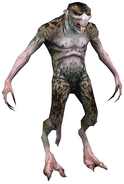mNo edit summary |
m (More of them are known, "notable" seem to be a better word) |
||
| Line 26: | Line 26: | ||
On [[Skellige]], a group of [[Svalblod]] worshippers invented a "controlable" way to become [[werebear]]s. During a complicated ritual involving [[psilocybe]] mushrooms and what seemed to be allowing wild [[bear]]s to eat the cultists alive, the fierce warriors known as the Berserker used to rise. The bloodlust of Svalblod worshippers and their leader, jarl [[Knut the Callous]], ultimately led the Islanders to banish the cult and destroy the sacred sites of the werebear god.<ref name="tw3>{{Tw3}}</ref><ref name="gwent>{{Gwent standalone}}</ref> |
On [[Skellige]], a group of [[Svalblod]] worshippers invented a "controlable" way to become [[werebear]]s. During a complicated ritual involving [[psilocybe]] mushrooms and what seemed to be allowing wild [[bear]]s to eat the cultists alive, the fierce warriors known as the Berserker used to rise. The bloodlust of Svalblod worshippers and their leader, jarl [[Knut the Callous]], ultimately led the Islanders to banish the cult and destroy the sacred sites of the werebear god.<ref name="tw3>{{Tw3}}</ref><ref name="gwent>{{Gwent standalone}}</ref> |
||
| − | == |
+ | == Notable therianthropes == |
* [[Otto Dussart]] (werewolf) |
* [[Otto Dussart]] (werewolf) |
||
* [[Vincent Meis]] (werewolf) |
* [[Vincent Meis]] (werewolf) |
||
Revision as of 19:56, 13 August 2019
A therianthrope[1] is a human or a member of another humanoid race who, due to a curse, magical ritual or another circumstance, is affected by a therianthropy: a magical "disease" which changes the "contaminated" into an animal or human-animal hybrid during the full moon. During these three nights in a month, the therianthrope is not able to control themself and may be lethally dangerous for those nearby. Despite the folk tales, being bitten by a therianthrope very rarely results in acquiring the illness.[2]
An important difference between therianthropes and other Cursed Ones is that the therianthropy is hereditary. Those who have inherited it from one of their parents however are fully able to control their abilities and might change between one or three forms whenever they want, not only during the full moon.[1][3] One should also not compare them to other shapeshifting creatures such as aguaras – those are antherions, that is animals able to take a humanoid form rather than otherwise.[1]
Treatment
The only known method to treat therianthropy is to lift a curse. It is said to require a great pain and or personal loss[4] but other remedies such as wolfsbane or "finding a true love" are sometimes said to work.[5] However, all those treatments work only in case of those who aquired the therianthropy, and the inherited one cannot be lifted as it is not a result of a curse.[1][3]
When the bestial nature of a therianthrope starts to dominate over the sentient half, sadly the only choice left is usually to hire a witcher in order to end the killstreak. When facing a therianthrope, one should equip a silver weapon: their hardiness make them resilient to steel but a cursed nature of their illness make them very vulnerable to silver.
History
Therianthropy diseases appeared in the world after the Conjunction of the Spheres, affecting nonhuman and early human populations alike.[2] Entire regions such as the Toina valley, also called the Dogbane, were said to be plagued by werewolves before the Nordling colonization.[6]
On Skellige, a group of Svalblod worshippers invented a "controlable" way to become werebears. During a complicated ritual involving psilocybe mushrooms and what seemed to be allowing wild bears to eat the cultists alive, the fierce warriors known as the Berserker used to rise. The bloodlust of Svalblod worshippers and their leader, jarl Knut the Callous, ultimately led the Islanders to banish the cult and destroy the sacred sites of the werebear god.[7][8]
Notable therianthropes
- Otto Dussart (werewolf)
- Vincent Meis (werewolf)
- Anton the Bearded (werecat)
- Anton the Younger (werecat)
- Morkvarg (werewolf)
- Berem (werewolf)
- Little Red (werewolf)
- Niellen (werewolf)
Notes
- Despite their name, werebbubbs are not therianthropes. Were- part stands for were, an archaic term for male human. In original Polish edition, they are called bobołaks, and again the -łak has the elder meaning, coming from the Proto-Slavic lakъ, meaning skin. Bobołak is just one of numerous variants of similarly called creatures in several folklores, including Slovakian bubulak, Polish bobok, bebok, babok and babuk, Greek baboulas, Mediterranean babau, English bogeyman or bugbear, German Butzemann, Egyptian al-Bu'bu and many others. Therefore bobołak can mean bogey-skinned or bogey-man.
Gallery
References
- ↑ 1.0 1.1 1.2 1.3 Season of Storms
- ↑ 2.0 2.1 Wiedźmin: Gra Wyobraźni
- ↑ 3.0 3.1 The Witcher: Reasons of State
- ↑ The Witcher Role-Playing Game
- ↑ The Witcher
- ↑ Sword of Destiny
- ↑ The Witcher 3: Wild Hunt
- ↑ Template:Gwent standalone


